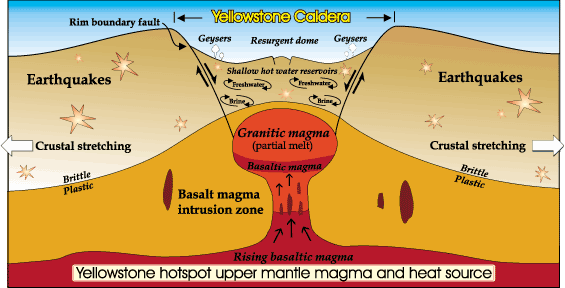57 share
Editor's notes: In answer to our headlined question, we say, "Who can say for certain." But, IF the animal population is making for the exits, that would seem to be of some concern. The question is this, however: is there an instinctive herd mentality driving wild life from the park? As a research editor, I have not seen any "head count" or definitive statement confirming such a migration. There is no overwhelming evidence of such an exodus.
The Park Service has its denial/explanation, below. This publication will monitor sources for the "truth" on this subject.
Park Service Explanation
The service also says on its website that “[There] is no evidence that a catastrophic eruption at Yellowstone National Park (YNP) is imminent. Current geologic activity at Yellowstone has remained relatively constant since earth scientists first started monitoring some 30 years ago. Though another caldera-forming eruption is theoretically possible, it is very unlikely to occur in the next thousand or even 10,000 years.
“The most likely activity would be lava flows such as those that occurred after the last major eruption. Such a lava flow would ooze slowly over months and years, allowing plenty of time for park managers to evaluate the situation and protect people. No scientific evidence indicates such a lava flow will occur soon.”
It did admit that the Yellowstone Volcano is still active, and that nothing can be done to prevent an eruption.
The National Park Service says that:
“At Yellowstone and some other volcanoes, some scientists theorize that the earth’s crust fractures and cracks in a concentric or ring-fracture pattern. At some point these cracks reach the magma ‘reservoir,’ release the pressure, and the volcano explodes. The huge amount of material released causes the volcano to collapse into a huge crater—a caldera.”

The Geological Service adds: “The youngest, the Yellowstone Caldera, was formed 640,000 years ago. Since then, about 80 eruptions of rhyolite (thick, sticky lava) and basalt (more-fluid lava) have occurred. The caldera’s interior is largely covered by rhyolites, most erupted in the past 160,000 years. Large hydrothermal (steam)-explosion craters formed in the past 14,000 years are located near Yellowstone Lake and in major geyser basins.
“Any renewed volcanic activity at Yellowstone would most likely take the form of such mainly nonexplosive lava eruptions. An eruption of lava could cause widespread havoc in the park, including fires and the loss of roads and facilities, but more distant areas would probably remain largely unaffected.”
The reader can reference the full article at The Epoch Times, here.
No comments:
Post a Comment